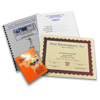 Home
Home
4-Hour First Responder Awareness
Click to sign up forour E-Newsletter

Jump To Section
Regulation | Open Enrollment Seminars | Other Course Options | Products for this Course
Open Enrollment Seminars
This class is not scheduled for any upcoming seminars. It is available for On-Site Training, Call or E-mail us to schedule a seminar.
Optionally, you can purchase the On-Site Training Seminar Kit below.
Course Regulation
29 CFR 1910.120:- (q)(6): Training. Training shall be based on the duties and function to be performed by each responder of an emergency response organization. The skill and knowledge levels required for all new responders, those hired after the effective date of this standard, shall be conveyed to them through training before they are permitted to take part in actual emergency operations on an incident. Employees who participate, or are expected to participate, in emergency response, shall be given training in accordance with the following paragraphs:
- (q)(6)(i): First responder awareness level. First responders at the awareness level are individuals who are likely to witness or discover a hazardous substance release and who have been trained to initiate an emergency response sequence by notifying the proper authorities of the release. They would take no further action beyond notifying the authorities of the release. First responders at the awareness level shall have sufficient training or have had sufficient experience to objectively demonstrate competency in the following areas:
- An understanding of what hazardous substances are, and the risks associated with them in an incident;
- An understanding of the potential outcomes associated with an emergency created when hazardous substances are present;
- The ability to recognize the presence of hazardous substances in an emergency;
- The ability to identify the hazardous substances, if possible;
- An understanding of the role of the first responder awareness individual in the employer’s emergency response plan including site security and control and the U.S. Department of Transportation’s Emergency Response Guidebook;
- The ability to realize the need for additional resources, and to make appropriate notifications to the communication center.
- It is also a prerequisite to the 24-Hour Emergency Response Technician Program.
The Following Topics are Covered in this Course
- Introduction
- Regulatory Overview
- Hazardous Substance Response
- Hazardous Substance Identification
- Emergency Response Preparedness
- Course Review / Final Test


Other Course Options
Seminar Kits for Instructors
$306.00 Add To Cart

Class Hours: 4
Regulation: 29CFR 1910.120 (q)
- 1 - Easy to Use Color Instructor Lesson Plan
- 10 - Student Workbooks
- 10 - Student Tests
- 10 - DOT Emergency Response Guidebooks
- 10 - Student Certificates
- 1 - Course PowerPoint® with Regulations
$22.00 Add To Cart

Additional student packs can be purchased to include:
- 1 - Student Workbook
- 1 - Student Test
- 1 - DOT Emergency Response Guidebook
- 1 - Course Certificate
Online Couse Options
View the online course requirements on our Online Courses Page.
$45.00 Add To Cart
 Prerequisite:
None
Prerequisite:
NoneClass Hours: 4
Regulation(s): 29CFR 1910.120 (q)(6)(i)
Course Code: FRA-OL
Course Description
This online instructional program is intended to help fulfill the training requirements for First Responder Awareness. As with any online training program, site specific hazards and procedures should be reviewed by enrollees of this program.
Our program is intuitive and easy to use for yourself and your employees. Order for your entire department and use our automated invitation program to send registration codes to each individual in your department.
As always you will receive the same product and content support as you have come to expect from New Environment, Inc. Professional HAZWOPER instructors are standing by to answer your questions and concerns before, during and after the completion of your training.
Course Regulation
29 CFR 1910.120:- (q)(6): Training. Training shall be based on the duties and function to be performed by each responder of an emergency response organization. The skill and knowledge levels required for all new responders, those hired after the effective date of this standard, shall be conveyed to them through training before they are permitted to take part in actual emergency operations on an incident. Employees who participate, or are expected to participate, in emergency response, shall be given training in accordance with the following paragraphs:
-
(q)(6)(i):
First responder awareness level. First responders at the awareness level are
individuals who are likely to witness or discover a hazardous substance release
and who have been trained to initiate an emergency response sequence by notifying
the proper authorities of the release. They would take no further action beyond
notifying the authorities of the release.
First responders at the awareness level shall have
sufficient training or have had sufficient experience to objectively demonstrate
competency in the following areas:
- An understanding of what hazardous substances are, and the risks associated with them in an incident;
- An understanding of the potential outcomes associated with an emergency created when hazardous substances are present;
- The ability to recognize the presence of hazardous substances in an emergency;
- The ability to identify the hazardous substances, if possible;
- An understanding of the role of the first responder awareness individual in the employer’s emergency response plan including site security and control and the U.S. Department of Transportation’s Emergency Response Guidebook;
- The ability to realize the need for additional resources, and to make appropriate notifications to the communication center.
- It is also a prerequisite to the 24-Hour Emergency Response Technician Program.
On-Site Training
New Environment, Inc. offers On-Site Training for this course, call or E-mail us to schedule this course.
Individual Products
Instructor Materials
$60.00 Add To Cart

The Following Topics are Covered by this Course
- Regulatory Overview
- Hazardous Material Classes
- Loading And Unloading
- Segregation Charts
- Hazardous Material Compliance Pocketbook
- 704 Marking System
- Hazard Communication Standard
- Elements Of A Material Safety Data Sheet
- Course Review And Final Test
$60.00 Add To Cart
 Fully editable PowerPoint presentation for 4-Hour First Responder Awareness
Fully editable PowerPoint presentation for 4-Hour First Responder Awareness
Student Materials
$16.00 Add To Cart

Student Material Includes:
- Student Background Survey
- Student Classroom Workbook
- 10 Question Test
- Certificate Of Completion*
- Participant Evaluation Form